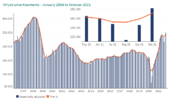pixel
DIY Trader
- Joined
- 3 February 2010
- Posts
- 5,359
- Reactions
- 344
Every month, the ABS publishes Employment data with various trend, change, and other related information. I could not find an ASF topic dedicated to discuss those figures in a broader economic context.
If anyone is interested, please join in.
Today's data for the month of March can be found at -
http://www.abs.gov.au/ausstats/abs@.nsf/mf/6202.0
What I find interesting:
If anyone is interested, please join in.
Today's data for the month of March can be found at -
http://www.abs.gov.au/ausstats/abs@.nsf/mf/6202.0
What I find interesting:
Specifically: Number of jobs went up a little, but hours worked declined. That means the quality of work and employees' take-home pay must have deteriorated. Good for business in the short-term, but what does it do for the average family's ability to pay bills and keep up spending?
- Employment increased 7,700 to 11,910,000.
- Unemployment decreased 2,800 to 729,600.
- Unemployment rate remained steady at 5.8%.
- Participation rate remained steady at 65.0%.
- Monthly hours worked in all jobs decreased 1.8 million hours to 1,643.7 million hours.



